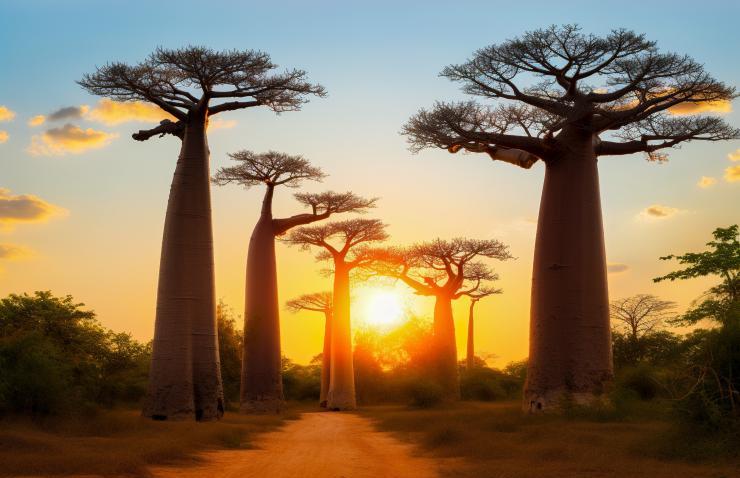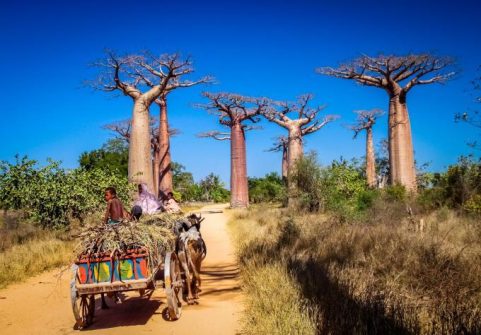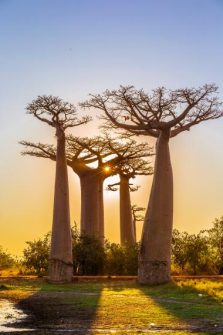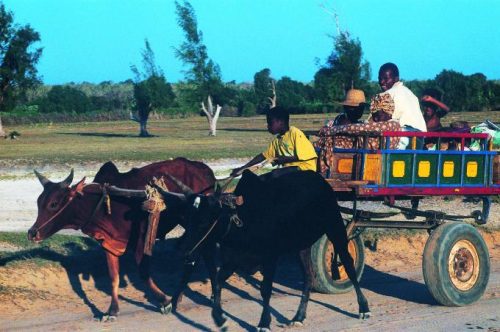Madagascar. Water from Baobabs .

In Madagascar, large centuries-old trees become cisterns to cope with the growing shortage of water. Baobabs are known for their size, hardiness, and impressive longevity.
Less known is their ability to conserve enormous quantities of water for a long time: a precious feature for those who live in the Mahafaly plateau, the driest region of the Great Island.
The Mahafaly plateau is one of the driest territories in Madagascar. Located in the southeastern part of the Big Island, it is populated by around 20,000 people belonging to the Mahafaly and Tandroy ethnic groups, who have learned to live in such a hostile environment.

Malagasy family travelling on a zebu cart on the sandy road going through the “Avenida the Baobab”. 123rf
Here it rains only a few times a year and the scant rainfall is immediately absorbed by the porous limestone soil. There are no rivers, lakes, or other natural water points.
A century ago, the region suffered a long period of drought that led to famine and the death of thousands of people.
Those who survived realized that they had to take action to avoid other water and humanitarian emergencies. It was then that the population of the plateau noticed a peculiarity of the baobabs: the ability of their trunks to store large quantities of water. When a baobab is struck by lightning, its trunk splits and the rain seeps into the cracks, small and large cracks, collecting in the cavities. Water does not penetrate the hard, compact wood of the tree, which does not rot. The water remains fresh and surprisingly pure.
Natural cisterns
The ‘barrel’ trunk of the baobab, characterized by a trunk that can reach a diameter of 8 metres, is a sort of natural ‘air-conditioned’ cistern capable of holding and conserving rainwater. The largest baobabs can store up to 14,000 litres of water, which the tree bark protects from external contamination.

Beautiful Baobab trees at sunset. The ‘barrel’ trunk of the baobab, is characterized by a trunk that can reach a diameter of 8 metres. 123rf
The Mahafaly communities have learned to transform these giants of nature into water reservoirs that allow them to cope with the harshest and hottest periods of the year.Each family is responsible for their own tree, which they look after with care. Ampotaka, with a population of 300 families, each with its own baobab, is a typical village of the region. Every June, two or three new trees are hollowed out to create new reservoirs, as older reservoirs lead to the slow deterioration of the tree which eventually collapses in on itself. To create a good cistern, the baobab must be relatively mature: speaking of plants that can live over a thousand years, ‘mature’ usually means being at least three hundred years old. Three people and at least ten days of work are needed to obtain the cavity of the desired volume. The larger the reservoir, the greater the chance of surviving droughts.
Difficult months
On the Madagascar plateau, water resources are carefully managed throughout the dry season, which generally runs from May to October… but can last much longer. For the first three months, the daily water requirement is met by reserves collected naturally in the hollow trees. In the following three months, the inhabitants go in search of tubers (such as mangeboka) and roots (baboke) which they squeeze to obtain drinking water and quench their thirst. Wild watermelons, used for cooking and drinking, are also rich in water.In July, the artificial baobab cisterns that fill up during the rainy season are reopened.

Each family is responsible for their tree, which they look after with care. File swm
The water inside them usually lasts until October and is used for drinking, cooking, and washing. If rainfall is delayed – and climate change makes the alternation of seasons increasingly uncertain – villagers are forced to make long cart journeys, 15-20 hours on bad roads, to reach the nearest place where it is possible to buy water. At that point, water consumption is extremely limited. Children are bathed only once a month. Not a drop should go to waste. People suffer from thirst and the weakest die of dehydration.
The vagaries of the sky are increasingly frequent and, while the eastern coasts of Madagascar are often plagued by violent hurricanes, the internal regions of the plateau are exposed to recurring periods of drought. This is why baobab cisterns are increasingly necessary. Their construction and maintenance are passed down from generation to generation. Each tree is baptized with the name of a newborn so that, once an adult, he can take care of his own baobab. (Open Photo:123rf)
Pascal Maitre/Africa



